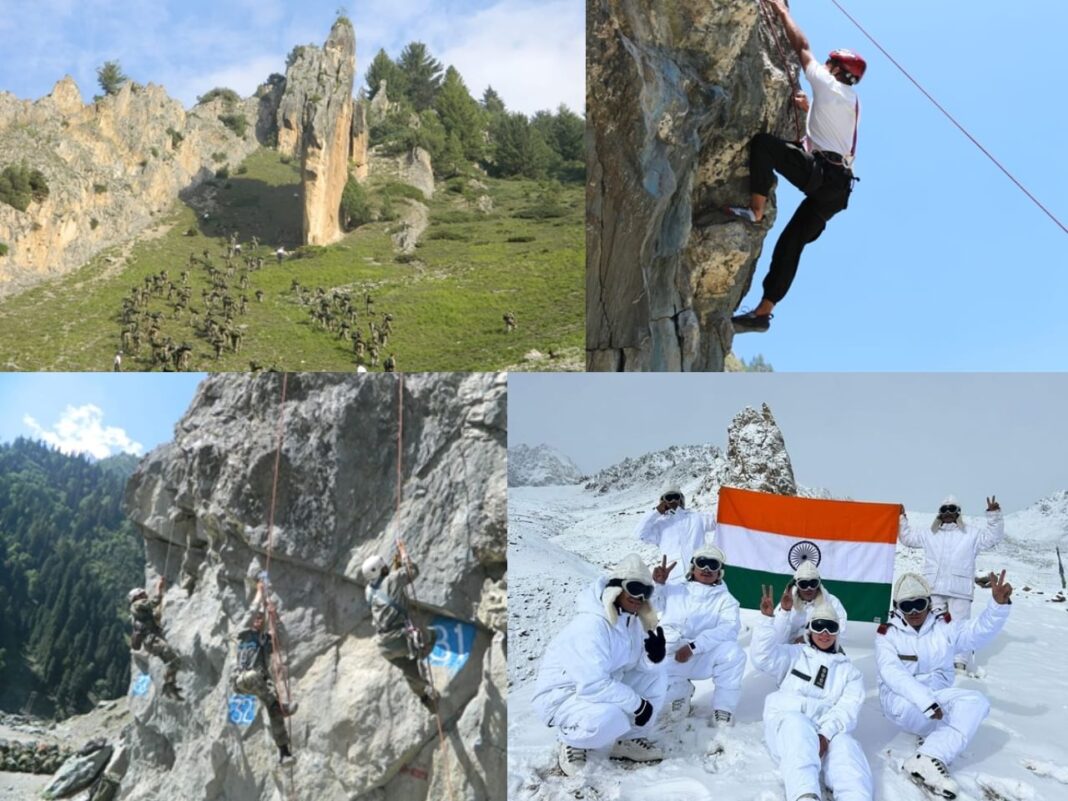New Delhi: Walking several miles with 15 kg of loads on the back and an assault rifle in hand in precipitous terrain and defeating penetrating cold is the day-to-day drill of an Indian soldier posted at Siachen Glacier. Here, the hostile weather is more dangerous than the enemy standing on the other side of the border. The winter comes with more challenges, as the bone-chilling cold and rugged surface make it more difficult for the soldiers to conquer the battleground located in the eastern Karakoram Range in the Himalayas, and situated at an average altitude of 18,000 ft above sea level.
However, such harsh conditions do not have an impact on the motivation and dedication of a warrior. That is all because they are not only trained to eliminate enemies but also to defeat unprecedented weather conditions at such an altitude. And the credit goes to High Altitude Warfare School (HAWS), where most of the soldiers are crafted to survive in intense weather conditions and guard the national border at Siachen Glacier.
Next to God, remember HAWS “When in the mountains, when you are in trouble or lost next to god, remember HAWS”, screams a large board as one enters the main building of the HAWS, a defence service training and research establishment of the Indian Army at Gulmarg, Jammu and Kashmir. The HAWS, a destination that can be reached after a picturesque 45 minute uphill drive through narrow, slippery roads from the foothills of Apharwat peak, was established as a ski school in 1948 and later turned into the High Altitude Warfare School. Socialized in snow–craft and winter warfare, the HAWS is situated in an area that is prone to avalanches.
The centre not only prepares Indian soldiers but also crafts selected soldiers from the US, UK, Germany and other countries who visit regularly for specialist training. From Ski School to becoming High Altitude Warfare School The loss of Gilgit-Baltistan in the Siege of Skardu to Pakistan in the 1947–1948 Indo-Pakistani War, led to the birth of the Indian Army’s High Altitude Warfare School (HAWS) in 1948. The school was established by General K S Thimayya, then holding the rank of Brigadier, in December 1948 and was originally called the 19 Infantry Division Ski School.
Later, during the winter of 1949–1950, the school was renamed the Winter Warfare School and reclassified as a Command Establishment. Furthermore, the school was renamed and upgraded to a Category A Training Establishment on April 8, 1962 and adopted its current name. The training at the soldier launchpad The soldiers at HAWS go through rigorous training that is conducted in two phases.
The first phase is a basic course of seven weeks, followed by an advanced course of four weeks. The soldiers and officers here in HAWS are trained in High Altitude Warfare, Snow Cliff Climbing, Mountain Survival Skills and Ice Crafting. Operating from three different locations in Kashmir, the school conducts mountain warfare courses at Sonamarg, winter warfare courses at Gulmarg, and ice craft at Machoi across Zojila.
Residing in the heart of the beautiful Gulmarg valley, the school has a different world inside. While the world outside the school presents a beautiful and serene picture, the inside world puts the human body and spirit to test. According to the commandant of the school and quoted by the Economic Times, training at HAWS is one of the toughest courses that an army man undergoes, and thus the dropout rate ranges between 30 and 40 per cent.
The seriousness of the training can be understand through the serious injuries and problems encountered by the students when they reach the training establishment, which include a rise in blood pressure and difficulty breathing, followed by headaches, because of the high altitude. The first week of training, which takes place on the Pir Panjal ranges in an area known as the ‘Gujjar Hut’, begins with a small walk of about 1. 5 kilometres with a little load on one’s back.
The weight on the back soon increases to 5 kg, 10 kg and 15 kg after two weeks, along with increased distance. While trekking and physical activities are conducted for the soldiers to keep them acclimatised, Exercise Veer Dola is conducted to prepare the soldiers for a real-time scenario of mountain warfare. The seriousness and toughness of the training go beyond the imagination of a normal people week after week.
And at the end of the training, what remains with the soldiers is a tough physique and a sharp mind to overcome any situation in the mountain region. In addition to tough survival training, the soldiers at the school are also prepared for winter sports such as snowboarding, alpine skiing and Nordic skiing, ice hockey and ice skating, among others. Notably, the specialised team of HAWS is always on their toe for any kind of rescue operation in the Himalayan Ranges.
The training centre recently added facilities to allow the Indian Army ski team to train at night. The importance of Siachen area A border conflict with Pakistan has compelled the Indian Army to take control of the 100-kilometre-long Saltoro Range in the Siachen area. It cannot be forgiven even in the toughest conditions, such as frequent blizzards and sub-zero temperatures, which make it one of the most hostile places to live in.
Thus, the soldiers are trained to survive in any hostile weather condition to guard the world’s highest battlefield. .
From: news9live
URL: https://www.news9live.com/knowledge/high-altitude-warfare-school-astonishing-facts-about-the-training-centre-of-indian-soldiers-guarding-siachen-glacier-2377360



